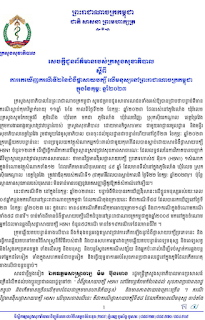#17,308
About an hour after I posted yesterday's report (see Cambodia: Media Reports Of An H5N1 Death (11 y.o. Child). a second report emerged in the media stating that there were 12 additional H5N1 infections in Cambodia, although a careful reading cast serious doubt on the story.
It is not unusual for media reports, which are often translated from another language, and/or written by someone without much knowledge of the subject, to get things wrong. Particularly in the early days of an outbreak.
Those who have been doing this a long time, like the newshounds at FluTrackers, and senior science writer at STAT, Helen Branswell acknowledged the reports, but also questioned their validity. Many others on twitter, and even in the media, simply repeated the story as if it were confirmed.
Rather than compound a felony, I elected to hold off until more information became available.
Overnight, many media outlets amended their initial headlines to say 12 `suspected' or `possible' infections. And just a few hours ago the Cambodian MOH released the following statement that confirms just 1 additional infection out of 12 samples tested; the father of the 11 y.o. girl who died.
Machine translations can produce challenging syntax, and even this one requires a careful reading. However, it clearly states there are (as of right now), only two cases in Cambodia.The Ministry of Health of the Kingdom of Cambodia would like to inform the public that after the death of an 11-year-old 6-month-old girl on February 22, 2023, living in Roleang village, Romlech commune Romchek came back to Roleang village, Romlech commune), Sithor Kandal district, Prey Veng province. In February 2023, the emergency response team collected samples from 12 girls who died of H5N1 bird flu for analysis at the Public Health Research Institute. One of the 12 specimens of the H5N1 bird flu virus in a 49-year-old man living in Roleang village, Romlech commune, Sithor Kandal district, Prey Veng province, was the father of the first case. The girl who died on February 22, 2023). But the man's health has not yet shown any significant symptoms.
This is the second case in February 2023 after the virus was not found in humans for the past 9 years in the Kingdom of Cambodia, the latest case is the 58th case found in As of February 23, 2023, there were 45 cases of children under 14 years of age and 31 cases out of 58 cases were women. Since the first outbreak of bird flu in the Kingdom of Cambodia in 2005, of the 58 cases of the H5N1 bird flu virus, only 19 have survived.
The emergency response team has been investigating the outbreak of bird flu and responding to national procedures and has coordinated the emergency response team, human and veterinary, and the search for the source of the infection. Animals and humans will continue to search for suspected cases and victims to prevent transmission to others in the community and conduct health education campaigns in the villages where the above incidents occur.
Once again, HE Professor Mam Bunheng, Minister of Health, reminded the general public that "H5N1 avian influenza continues to pose a threat to the health of the Cambodian people and is more prevalent in high-risk and high-risk children." The H5N1 bird flu virus in men is the 58th case in humans.
Office of the Ministry of Health, Plot No. 80, Samdech Pen Nuth (St. 289), Phnom Penh Tel: (855-23) 885970/884909
For now, the father does not appear to be severely impacted by his infection. That could change, of course, but it has often been noted in the past that children and adolescents tend to be more severely infected with H5N1 than do older adults.
One possibility we've explored, however, is that your first flu exposure may affect your future response to novel flu viruses (see Science: Protection Against Novel Flu Subtypes Via Childhood HA Imprinting).
It is highly likely we'll continue to see sporadic human infections with H5N1, as the virus continues to evolve, and spread, globally. We may even see some clustering of cases, which could suggest limited human-to-human transmission.
We've certainly seen both in the past.
But to pose a serious pandemic threat, the virus needs to adapt well enough to human physiology to transmit efficiently from human-to-human. And that hasn't happened yet. Maybe it never will.
But the next pandemic virus is probably already out there, honing its ability to infect humans, and we'd better be prepared for it when it comes.


